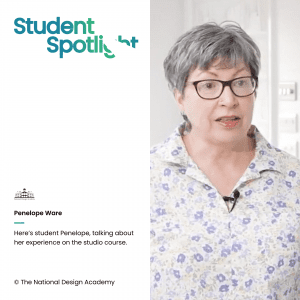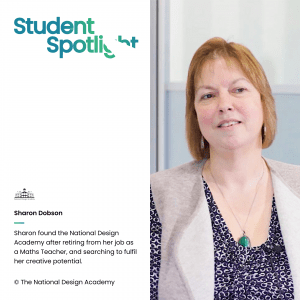
Student Spotlight: Janey Keirs, Diploma in Professional Soft Furnishings & Curtain Making
From Crafting for Fun to a Thriving Creative Business: Meet Janey For some, creativity is a hobby. For others, it quietly weaves its way through every
As a not-for-profit foundation, we are so confident in the price of our Diploma’s that if you can find the same level of education for less, we will match it!

No previous qualifications required! Age 16+ and an interest & enthusiasm for soft furnishings for interior design.

10 days In-Studio + Up to 10 weeks of home study projects

Week 1: 26th - 30th January
Week 2: 9th - 13th March

No exams — Tutor assessment only, portfolio moderation by AIM Qualifications.
With these skills you will be able to tackle your own projects more professionally, start your own business or enter the curtains and soft furnishing industry with the practical knowledge required to work with your clients.You’ll also learn how to establish industry contacts, where to source material, samples, fittings and accessories, everything you need to start building a professional design community with your peers.
Whilst receiving hands-on advice directly from our highly experienced NDA Tutors, the In-studio course brings together a fantastic mix of students, helping to create an exciting, friendly and dynamic class with the chance to share ideas with fellow up and coming designers.
The Diploma course consists of a first week (5 days) in-studio followed by 5 weeks of home study projects, then a second week (5 days) in-studio with an additional 5 weeks to complete any outstanding projects for submission to complete your course.
We are passionate about delivering high-quality courses to our students, and as we believe that students learn faster in smaller groups, we cap the student numbers attending each studio course.
Nottingham, UK
January to March
February to April
May to July
September to November
You will study ten dedicated units during this Professional Diploma

This unit introduces you to the essential tools, terminology and techniques that form the foundation of professional curtain making and soft furnishings. You’ll learn how to measure windows, carry out site surveys, and understand how different treatments transform a room. Through hands-on activities, you’ll build core construction skills such as cutting, stitching and creating trims, giving you the confidence to approach a variety of projects with precision and creativity. This unit also includes:

This unit explores the fascinating world of fabrics and colour, helping you choose the right materials for any curtain or soft furnishing project. You’ll discover how different fabrics perform, when and why fire-retardant treatments are essential, and how colour can transform a space both visually and emotionally. By applying colour theory and exploring trends, you’ll gain the confidence to create inspiring schemes that enhance mood, style and proportion. This unit also includes:

This unit builds your skills in making beautifully finished, professional-quality curtains. You’ll learn how to select the right fabrics, linings, interlinings, fixtures and fittings, while developing the precision needed to calculate fabric quantities for both plain and patterned designs. Through hands-on practice, you’ll refine techniques such as mitred corners, weights, trims and heading tapes, ensuring every curtain you create achieves an accurate fit and a flawless finish. This unit also includes:

This unit introduces you to the art of creating handmade headers, a traditional technique that gives curtains and valances a truly bespoke finish. You’ll explore a variety of styles, from triple and double pleats to goblet and cartridge designs, learning how different combinations transform the look of a window treatment. Through practical activities, you’ll master the skills of calculating pleats, preparing fabrics, inserting buckram and adding trims, achieving professional results every time. This unit also includes:

This unit focuses on the skills needed to design and make beautifully tailored Roman blinds. You’ll learn how to select the right fabrics for both function and style, while understanding the safety standards and devices that must be applied for legal compliance. Through accurate measuring, precise cutting and professional construction techniques, you’ll create a fully functioning Roman blind, complete with panels or trims, ready for installation. This unit also includes:

This unit introduces you to the design and construction of cushions, combining style with functionality. You’ll explore a variety of cushion types, fillings, fabrics, trims and fastenings, learning how to select the right materials for different purposes. Through hands-on practice, you’ll refine skills in accurate measuring, preparing fabrics, and applying professional hand and machine stitching, enabling you to create beautifully finished cushions to a professional standard. This unit also includes:

This unit explores the design and construction of pelmets and tiebacks, essential finishing touches that enhance both the style and proportions of a window treatment. You’ll discover how different shapes, materials and trims create looks suited to traditional or contemporary interiors. Through practical activities, you’ll learn how to prepare templates, cut and stiffen fabrics, add decorative details and apply stitching techniques, before completing each piece with professional fixtures and fittings. This unit also includes:

This unit prepares you to develop the skills and knowledge needed to plan and run a curtain making and soft furnishing business. You’ll learn how to set up an efficient workroom, manage costs and price your services accurately to help ensure profitability. You’ll also explore how to attract clients, build a professional brand and establish strong supplier relationships, giving you the confidence to launch and grow your own soft furnishing enterprise. This unit also includes:

This unit introduces you to the essential tools, terminology and techniques that form the foundation of professional curtain making and soft furnishings. You’ll learn how to measure windows, carry out site surveys, and understand how different treatments transform a room. Through hands-on activities, you’ll build core construction skills such as cutting, stitching and creating trims, giving you the confidence to approach a variety of projects with precision and creativity. This unit also includes:

This unit explores the fascinating world of fabrics and colour, helping you choose the right materials for any curtain or soft furnishing project. You’ll discover how different fabrics perform, when and why fire-retardant treatments are essential, and how colour can transform a space both visually and emotionally. By applying colour theory and exploring trends, you’ll gain the confidence to create inspiring schemes that enhance mood, style and proportion. This unit also includes:

This unit builds your skills in making beautifully finished, professional-quality curtains. You’ll learn how to select the right fabrics, linings, interlinings, fixtures and fittings, while developing the precision needed to calculate fabric quantities for both plain and patterned designs. Through hands-on practice, you’ll refine techniques such as mitred corners, weights, trims and heading tapes, ensuring every curtain you create achieves an accurate fit and a flawless finish. This unit also includes:

This unit introduces you to the art of creating handmade headers, a traditional technique that gives curtains and valances a truly bespoke finish. You’ll explore a variety of styles, from triple and double pleats to goblet and cartridge designs, learning how different combinations transform the look of a window treatment. Through practical activities, you’ll master the skills of calculating pleats, preparing fabrics, inserting buckram and adding trims, achieving professional results every time. This unit also includes:

This unit focuses on the skills needed to design and make beautifully tailored Roman blinds. You’ll learn how to select the right fabrics for both function and style, while understanding the safety standards and devices that must be applied for legal compliance. Through accurate measuring, precise cutting and professional construction techniques, you’ll create a fully functioning Roman blind, complete with panels or trims, ready for installation. This unit also includes:

This unit introduces you to the design and construction of cushions, combining style with functionality. You’ll explore a variety of cushion types, fillings, fabrics, trims and fastenings, learning how to select the right materials for different purposes. Through hands-on practice, you’ll refine skills in accurate measuring, preparing fabrics, and applying professional hand and machine stitching, enabling you to create beautifully finished cushions to a professional standard. This unit also includes:

This unit explores the design and construction of pelmets and tiebacks, essential finishing touches that enhance both the style and proportions of a window treatment. You’ll discover how different shapes, materials and trims create looks suited to traditional or contemporary interiors. Through practical activities, you’ll learn how to prepare templates, cut and stiffen fabrics, add decorative details and apply stitching techniques, before completing each piece with professional fixtures and fittings. This unit also includes:

This unit prepares you to develop the skills and knowledge needed to plan and run a curtain making and soft furnishing business. You’ll learn how to set up an efficient workroom, manage costs and price your services accurately to help ensure profitability. You’ll also explore how to attract clients, build a professional brand and establish strong supplier relationships, giving you the confidence to launch and grow your own soft furnishing enterprise. This unit also includes:
Images of our talented Diploma students hard at work in our In-Studio sessions
UK residents pay approximately 50% course fees and funding from the UK government will pay the rest.
All NDA Professional Diplomas are accredited by AIM Qualifications. NDA is the only design school to be able to offer funding & student loans because our Diplomas are fully accredited.
There are two ways for UK students to pay for their In-Studio Diploma:
There are two ways for International students to pay for their In-Studio Diploma:
In-Studio Study – All required equipment and resources will be provided during your time In-Studio, however you will need access to a laptop computer to view course material and the online learning resources.
Home Study – Alongside a computer and an internet connection, there is also essential and recommended equipment required to complete your NDA Course, all available through the NDA Art Shop at student prices! Throughout home study, you have full online access to our resources and your Personal Tutor.
The Diploma in Professional Soft Furnishings & Curtain Making is designed to help you start your own Soft Furnishings Workroom and Design Service. In the same way you have studied the Diploma course, you can work flexibly for your clients around your family commitments and gradually expand your business. You could also study the Professional Interior Design Diploma to offer additional design services to your clients.
Successful completion of your NDA Diploma provides a guaranteed place on one of our online BA (Hons) degrees with a generous Progression Scholarship. Degrees are validated by De Montfort University (DMU).
For those who wish to continue their study at an on campus university, all NDA Professional Diplomas carry a UCAS tariff point value. You can top up any existing UCAS points you may have with points from an NDA Diploma.
Diploma in Professional Soft Furnishings & Curtain Making = 32 UCAS tariff points.

From Crafting for Fun to a Thriving Creative Business: Meet Janey For some, creativity is a hobby. For others, it quietly weaves its way through every

Our Diploma in Professional Soft Furnishings & Curtain Making is the ideal course if you want to design your own projects, help your friends and family

“For me, the beauty of how the course is put together, is you can see your own personal journey” During a recent in-studio course at the
Hear what past and present students have to say about studying In-Studio at the NDA
UK students pay approximately 50% of the full course fee – the balance is funded by the UK Government’s Adult education budget (AEB).
The National Design Academy is the only design school to be able to offer this funding as our Diplomas are all fully accredited by AIM Qualifications.